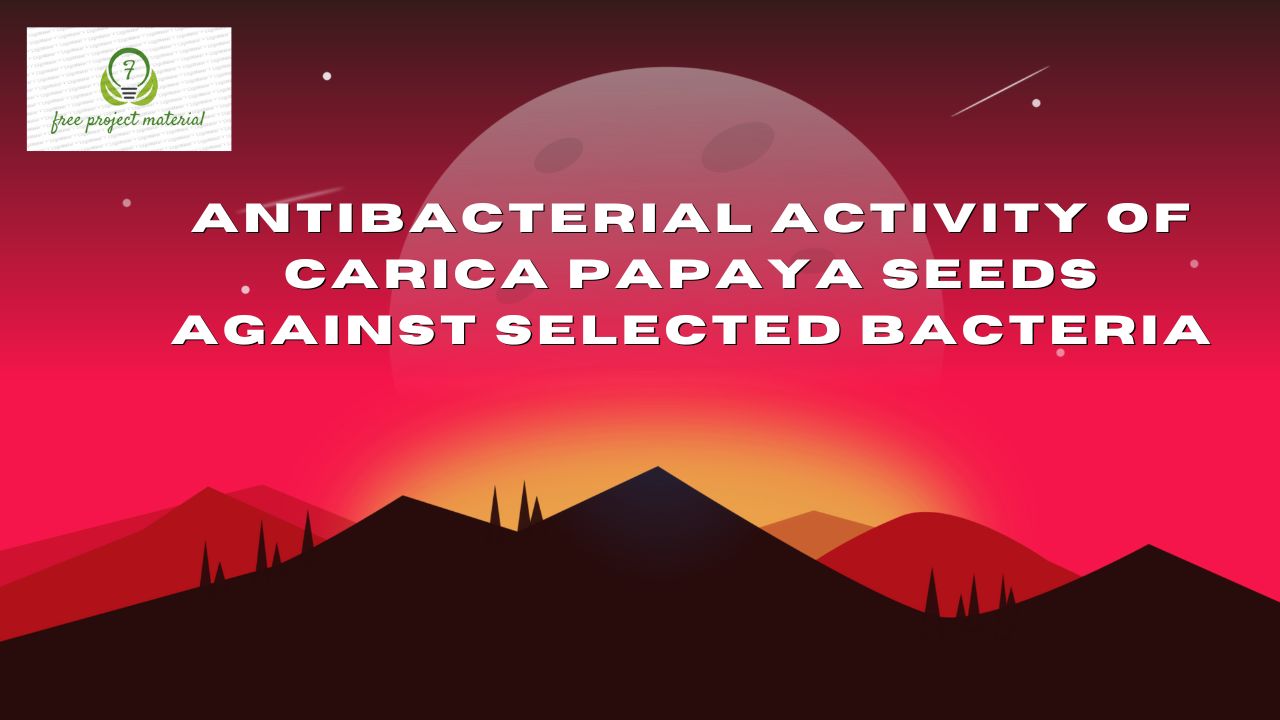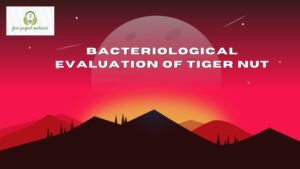ABSTRACT
The menace of antibiotic resistance and the antecedent evolution of innocuous microbes into superbugs is an epidemic of global concern. This study investigated the antimicrobial activity of ethanolic extracts and aqueous extract of Carica papaya seeds on Staphylococcus aureus, Escherichia coli, Streptococuss sp, and Bacillus sp standard methods were employed and disc diffusion method used for antimicrobial analysis. The extract possess antimicrobial properties at concentration ranging from 100%, 80%, 50% and 20%. the minimum inhibitory concentration (MIC) was recorded ethanol extracts aqueous extract on the test organisms. Result shows that there was variations in the level of activity against the test organism. The potent antimicrobial effect of these extracts indicate that it may be used in the treatment of bacterial infection including the multi- drugs resistant ones.
TABLE OF CONTENT
Title Page – – – – – – – – – i
Certification – – – – – – – – ii
Dedication – – – – – – – – iii
Acknowledgement – – – – – – – – iv
Abstracts – – – – – – – – – v
Table of Contents – – – – – – – vi
CHAPTER ONE: INTRODUCTION
1.1 Background of the study – – – – – 1-3
1.2 Aim and Objectives of the study – – – – 3
1.2.1 Aim of this study – – – – – – – 3
1.2.2 Objectives – – – – – – – – 3
CHAPTER TWO: LITERATURE REVIEW
2.1 Description of Carica papaya – – – – – 4-6
2.2 Origin and Distribution of Carica papaya – – 6-7
2.3 Classification of Carica papaya – – – – – 7-8
2.4 Nutritional Value – – – – – – – 8-9
2.5 Therapeutic and Medicinal Values of Carica papaya – 10-12
2.6 Chemical Constituents of Carica papaya – – – 13-14
2.7 Pharmacological Studies of Carica papaya – – – 14
2.7.1 Antidiabetic Activity – – – – – – 14-15
2.7.2 Antimicrobial Activity – – – – – – 15
2.7.3 The Anti-inflammatory Activity – – – – – 15-16
2.7.4 Wound Healing Activity – – – – – – 16-17
2.7.5 Antiplasmodial Activity – – – – – – 17
2.8 Cosmetic Benefits of C. papaya – – – – 18
CHAPTER THREE: MATERIALS AND METHOD
3.1 Material – – – – – – – – 19
3.2 Methods – – – – – – – 19
3.2.1 Sample collection – – – – – – – 19
3.2.2 Sterilization of glassware and media preparation. – – 19-20
3.2.3 Sample Preparation of Aqueous and Ethanol extract – – 20
3.2.4 Collection of test organisms – – – – – 20-21
3.2.5 Characteristics and Identification of Isolates – – 21
3.3 Preparation of Antimicrobial Disc – – – – 22
3.3.1 Disc Diffusion method – – – – – – 22
3.3.2 Determination of minimum inhibitory
concentration (MIC) by both Dilution Method – – 23
CHAPTER FOUR: RESULTS AND DISCUSSION
4.1 Results – – – – – – – – 24-28
4.2 Discussion – – – – – – 29-30
CHAPTER FIVE: CONCLUSION AND RECOMMENDATION
5.1 Conclusion – – – – – – – – 31
5.2 Recommendation – – – – – – 31
References
Appendix
CHAPTER ONE
1.0 INTRODUCTION
1.1 Background of the study
Currently, there has been a lot of attention focused on producing medicine and products that are natural. Several leaves and leaf extracts have been found to have antimicrobial activity microorganisms (Kim et al., 2004). This suggests the plants which manifest relatively high levels of antimicrobial action may be a source of compound that can be used to inhibit the growth of food borne pathogens (Biswas et al. 2014).
There is no plant that does not have medial value. The active components are normally extracted from all plant structures, but the concentration of these compounds varies from structure to structure. However, plant parts known to contain. The highest concentration if these phytochemical constituent it therapeutic purpose can either be leaves, stem bark, root, bulks, corms, rhizomes, wood, flower, fruit or the seeds (Biswas et al., 2014).
The presence of phytochemical constituents in medicinal plant made them useful or healing as well as for curing of human diseases. Phytochemical are naturally occurring compounds in the plant. Large populations of the world, especially in developing countries depend on the traditional system of medicine to treat variety of diseases. Several hundred genera of plants were used traditionally for medicinal purposes. The World Health Organization reported that 80% of the world population relies chiefly on traditional medicine and a major part of the traditional therapies which involve the use of plant extracts and their constituent (Wadood et al., 2013).
Carica papaya L. belong to the family of Caraicacea, and several species of caricaceae have been used as a remedy against a variety of diseases. Carica papaya L. is commonly called Pawpaw (English) Gwanda (Hausa), Ibebe (Yoruba) or okoegbe (Igbo). It is a mono-sexual plant of Central American Origin (Douchari et al., 2007).
Besides the fruit being reported, it has been reported that the roots and the leaves have been used as antihelminthes and for the treatment of infection of bacterial origin.
Papaya leave extracts have phenolic compound and caffeic acid. Carica papaya plant produce natural compound in leaf and bark as well. As thig tissues that poses both highly anti-tumor and pesticide properties (Whosha and Mangalanagaki, 2013).
In the present research, the extracts (both aqueous and enthanolic) from leaves and stem of Carica papaya were screened for antibacterial activity and phytochemical analysis. The minimum inhibitory concentration (MIC) and minimum bacterial concentration (MBC) of the extract were also determined
1.2 Aim and Objectives of the study
1.2.1 Aim of this study
To access the antibacterial activity of Carica papaya seeds against selected bacteria
1.2.2 Objectives
- To isolate and identify selected bacteria for the study.
- To access the antibacterial effect of the selected bacterial isolate.
To make recommendations base on the result of the work.


